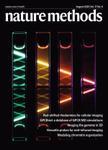版权所有:内蒙古大学图书馆 技术提供:维普资讯• 智图
内蒙古自治区呼和浩特市赛罕区大学西街235号 邮编: 010021

作者机构:Vienna Bioctr Res Inst Mol Pathol IMP Vienna Austria Thermo Fisher Sci Bremen Germany Austrian Acad Sci Vienna BioCtr Inst Mol Biotechnol IMBA Vienna Austria Univ Vienna Vienna BioCtr PhD Program Doctoral Sch Vienna Austria Med Univ Vienna Vienna Austria Austrian Acad Sci Vienna Bioctr Gregor Mendel Inst Mol Plant Biol GMI Vienna Austria
出 版 物:《NATURE METHODS》 (Nat. Methods)
年 卷 期:2025年第22卷第3期
页 面:1-10页
核心收录:
学科分类:0710[理学-生物学] 07[理学] 09[农学]
基 金:Vienna Science and Technology Fund (Wiener Wissenschafts-, Forschungs- und Technologiefonds) [2022/01] Austrian Research Promotion Agency (FFG) [LS20-079] Vienna Science and Technology Fund (WWTF) [DOI 10.55776/P35045] Austrian Science Fund (FWF) [DOI 10.55776/ESP497]
摘 要:Despite significant advancements in sample preparation, instrumentation and data analysis, single-cell proteomics is currently limited by proteomic depth and quantitative performance. Here we demonstrate highly improved depth of proteome coverage as well as accuracy and precision for quantification of ultra-low input amounts. Using a tailored library, we identify up to 7,400 protein groups from as little as 250 pg of HeLa cell peptides at a throughput of 50 samples per day. Using a two-proteome mix, we check for optimal parameters of quantification and show that fold change differences of 2 can still be successfully determined at single-cell-level inputs. Eventually, we apply our workflow to A549 cells, yielding a proteome coverage ranging from 1,801 to a maximum of 5,300 protein groups from a single cell depending on cell size and search strategy used, which allows for the study of dependencies between cell size and cell cycle phase. Additionally, our workflow enables us to distinguish between in vitro analogs of two human blastocyst lineages: naive human pluripotent stem cells (epiblast) and trophectoderm-like cells. Our data harmoniously align with transcriptomic data, indicating that single-cell proteomics possesses the capability to identify biologically relevant differences within the blastocyst.